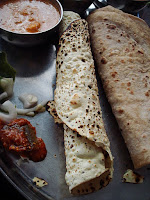Papad is an Indian delicacy made from seasoned dough
flour. The type of flour used in the preparation of papad depends on the
region.
Different food base are used in the preparation of papad
such as rice, potato and lentils. The flour based wafer like snack is common to
many East Asian countries.
Major regions you find the delicious food are Sri-Lanka,
Bangladesh, Pakistan, Nepal and India. Usually served as an appetizer the snack
is deep fried, heated, baked or cooked.
Papad is known by many names depending on the country or
region. Some of the common alternate names are paoadum, appadum, papari, papad,
popardum and papad. The varied names attests to the popularity of this snack.
Startup cost of a papad making business is low and the
equipment is basic and easily bought in the open market. Papad comes in an
unusually large number of variety increasing the popularity and demand.
To start the enterprise you need to write a papad
business plan and carry out a feasibility study.
Papad
Making Business in India
Ways
of Preparing Papad
The main ingredient in papad is black gram, potato, rice,
chickpeas or lentis. Dough is made using one of the mentioned ingredients
including oil and salt.
Some producers sometimes add baking soda to the dough.
The flavor depends on the producer and region.
Common flavor found in papad are garlic, ginger, black
pepper, spices and chili pepper. The common denominator of papad is it round
flatbread like shape.
The dough is rolled and flattened into round flatbread
and heat is applied. The heating method also differs based on the producer’s
preference.
Papad is roasted, baked, deep fried, microwave, roasted
in open flame or toasted. The versatility of the preparation method provides
the producer much equipment options.
The preparation involves kneading the dough into round
flatbread adding salt and pepper then heated. Traditional methods require no
mechanized equipment and the papad is merely sun-dried.
Registering
the Papad Business
The small business owner could register the business as a
one man enterprise. Incorporate the business as a sole proprietorship and
select a business name.
You need to pass a
standard health inspection test and product standardization test. Papad
attracts value added tax and you need a trade license to sell commercially.
Financing
the Papad Business
Running a papad business is low cost and does not require
major funding. Try target savings in a commercial bank or borrow money from friends
and family.
The capital is required for purchase of raw material and
storage facility. The cost of equipment is also minimal depending on the
heating methodology you prefer.
Approach a micro finance institution, merchant banks,
producers associations for soft loans.
Raw Materials
used in Making Papad
Make sure the main raw material is abundant and readily
available in the market. Depending on your region and ingredient preferred by
customers select easily obtained ingredients.
Good locations to source raw materials are farms, farmers
markets and open market. Try to purchase the ingredients from wholesalers or
retailers.
Common ingredients are garlic, salt, black pepper, flour
and red chili powder. Others are peanut oil, sesame seeds, asafetida, cumin and
baking soda.
Types
of Papad
There are different types of papad based on the
ingredient used to make the flatbread. We have the Rice papad, Potato papad,
Roasted papad and the famous Uradal papad.
More types include Masala papad, Paparis, toasted papad
and fire toasted papad.
Manufacturing
Process for Papad
Papad is made through a manual process that required exertion
or automatic or semi automatic process. We have the automatic papad making
machine or hand press machine. Other equipment's are drier machine, weighing
machine and packaging machine.
Final
Word
Papad is generally sold in the open market and accounts
for a huge billion dollar industry. There are a few major producers of papad in
India however there is room for small and medium entrepreneurs.
There are also many import destinations such as the United
Arab Emirates, Kuwait, Bahrain, Singapore and United States of America. How to Start a Potato Chips Business<










0 comments:
Post a Comment